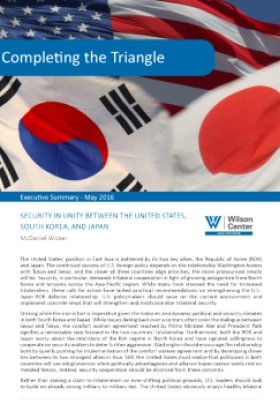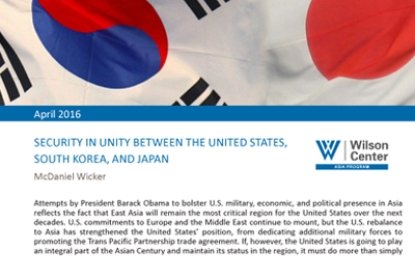Completing the Triangle: Executive Summary


The United States’ position in East Asia is bolstered by its two key allies, the Republic of Korea (ROK) and Japan. The continued success of U.S. foreign policy depends on the relationship Washington fosters with Tokyo and Seoul, and the closer all three countries align priorities, the more pronounced results will be. Security, in particular, demands trilateral cooperation in light of growing antagonism from North Korea and tensions across the Asia-Pacific region. While many have stressed the need for increased trilateralism, these calls for action have lacked practical recommendations on strengthening the U.S.-Japan-ROK defense relationship. U.S. policymakers should seize on the current environment and implement concrete steps that will strengthen and institutionalize trilateral security.
Striking while the iron is hot is imperative given the histories and dynamic political and security climates in both South Korea and Japan. While issues dating back over a century often color the dialogue between Seoul and Tokyo, the comfort women agreement reached by Prime Minister Abe and President Park signifies a remarkable step forward in the two countries’ relationship. Furthermore, both the ROK and Japan worry about the intentions of the Kim regime in North Korea and have signaled willingness to cooperate on security matters to deter further aggression. Washington should encourage this relationship both by quietly pushing for implementation of the comfort women agreement and by developing closer ties between its two strongest allies in Asia. Still, the United States must realize that politicians in both countries will use old grievances when politically advantageous and alliance hopes cannot solely rest on mended fences. Instead, security cooperation should be divorced from these concerns.
Rather than staking a claim to trilateralism on ever-shifting political grounds, U.S. leaders should look to build on already strong military to military ties. The United States obviously enjoys healthy bilateral relationships with the two nations, consideringthe permanent basing of forces and frequent joint exercises, but military ties are also good between ROK and Japan. Korea already sends the second highest number of its officers to exchanges with the Japanese military, behind only the United States. Officials in the Blue House and the Ministry of National Defense (MND) are highly favorable of working more closely with Japan, according to a high ranking ROK officer. Similarly, former officials in Japan’s Ministry of Defense (MoD) have described stronger ties with Korea as “the only missing link” for national security.
The basic framework for U.S.-Japan-ROK trilateral military engagement already exists. The U.S. Secretary of Defense routinely meets with the minister from MND and MoD on the sidelines of multilateral events, and vice ministers and assistant secretaries from the three countries hold an annual Defense Trilateral Talk (DTT). Small-scale trilateral exercises and tabletop exercises (TTXs) have also occurred regularly in past, though these events lacked both scale and scope. Such trilateral activities provide a starting point for growing a strong trilateral alliance, and revitalizing these should be among the first steps taken. Rather than meeting only during the Shangri-La Dialogues, for instance, defense and foreign ministers should begin to hold a separate trilateral meeting, or 2+2+2, institutionalizing cooperation by both ensuring diplomatic and security agendas progress simultaneously and by establishing a scheduled time to tackle the complex issues facing the three countries. The current DTT should also be bolstered for the same reason. More important than simply institutionalizing dialogue, however, will be producing meaningful action in these meetings. The end goal should be to have near seamless interoperability, frequent trilateral exercises with dynamic scenarios, and even joint operations. Achieving this will take firm U.S. leadership (though not necessarily publicly) and a commitment to completing the processes over many years or even administrations.
Robust trilateral interaction at the leadership level is one key to bolstering the relationship, but a number of other steps must also happen in the near-term to build toward a true trilateral alliance. Reestablished TTXs and trilateral exercises should be complex events that address the critical challenges facing Northeast Asia. Previous exercises revolved around familiarization and technical training, whereas robust exercises based on realistic scenarios would highlight the need for cooperation among all three nations and actually prepare for potential incidents in the region. It is particularly important for Korean officials to realize the importance of Japanese support to successful U.S.-ROK operations. U.S. government officials should stress this reality whenever they meet with their Korean counterparts—continually highlighting the need for Japanese logistical support, at a minimum, for the success of any contingency on the Peninsula. Simply put, Japanese involvement in security matters is essential to ROK national interests, and the United States should focus on trilateralism’s benefit to Korea rather than merely explaining to Seoul why it is good for Washington. The Japanese, meanwhile, would significantly benefit from scenarios that allow them to practice their new capabilities under collective self-defense.
Maritime security offers the easiest starting point for serious trilateral efforts. Japan and South Korea worry greatly about anti-submarine warfare (ASW) in light of the North’s sizeable submarine and mini-sub fleet and its ongoing efforts to develop a submarine launched ballistic missile. The United States already has advanced ASW capabilities that would be beneficial for both allies. Joint minesweeping operations and maritime intelligence, surveillance, and reconnaissance (ISR) would also be a valuable
trilateral training target.
Missile defense presents another important area of mutual interest given Pyongyang’s large arsenal that contains weapons capable of hitting Korea, Japan, and U.S. territory. Each military already possesses strong capabilities to counter hostile missiles, but combining detection, tracking, and engagement capabilities creates a far stronger defense. Trilateral missile defense exercises could be easily and realistically planned and executed. Unlike maritime security, however, true integration of efforts requires
additional commitment from Japan and Korea. Having compatible, if not identical, systems is important to effective and efficient missile defense coordination, and Japanese and Korean acquisition of U.S. systems such as AEGIS, AEGIS Ashore, and THAAD would be a middle-term goal of to further strengthen the alliance.
Effective multilateral operations also require the ability to share information with partners. Currently South Korea and Japan lack a mechanism to directly share intelligence after the General Security of Military Information Agreement (GSOMIA) failed to win Korean approval in 2012. Despite potential opposition, the Abe and Park governments should move to reopen negotiations on GSOMIA as quickly as possible to allow for smooth trilateral coordination not just on missile defense but on all command and control issues. Only rapid action on the issue will capitalize on the current cooperative environment created by Pyongyang’s provocations, and without trust and urgency, the second attempt for GSOMIA will end much like the first.
The success of American efforts to develop a strong trilateral security alliance with Japan and South Korea ultimately depends on a few key elements:
• The United States must act quickly and decisively to capitalize on the unique environment created by improved bilateral relations between Seoul and Tokyo and North Korean provocations.
• Trilateral cooperation should be institutionalized through regular 2+2+2 meetings and joint exercises in order to separate the politicalized historical issues from national security.
• The United States should encourage and facilitate a new round of GSOMIA discussions so that joint planning, training, and execution are possible with all three countries.
• Trilateral exercises and TTXs should be scenario driven to address specific threats and build capability and interoperability, and these efforts should begin with areas of mutual interest that help counter North Korean aggression.
Developing trilateral capabilities in these areas would be the first steps in building a strong trilateral security alliance in Northeast Asia. They represent concrete methods to improve regional stability by countering North Korean aggression and protecting the people of Japan and South Korea. These efforts would also institutionalize defense cooperation between the United States, Korea, and Japan, creating regular defense engagements that are separate from the volatile historical issues. By doing so, the United States will make significant strides in its rebalancing efforts and in securing its position in the Asian Century.
Author

Officer, United States Air Force (Reserve)

Indo-Pacific Program
The Indo-Pacific Program promotes policy debate and intellectual discussions on US interests in the Asia-Pacific as well as political, economic, security, and social issues relating to the world’s most populous and economically dynamic region. Read more

Explore More
Browse Insights & Analysis
Completing the Triangle

The OSCE is a Good Value for America

